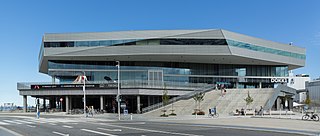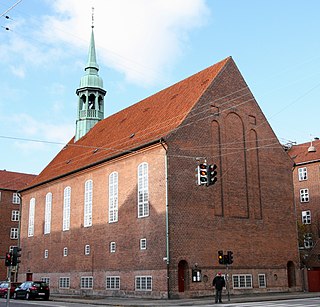Higher education in Denmark is offered by a range of universities, university colleges, business academies and specialised institutions. The national higher education system is in accordance with the Bologna Process, with bachelor's degrees, master's degrees and doctoral degrees. The majority of higher education institutions are the responsibility of the Ministry of Higher Education and Science; however, some higher education institutions within the arts are the responsibility of the Ministry of Culture.

The Royal Library in Copenhagen is the national library of Denmark and the academic library of the University of Copenhagen. It is among the largest libraries in the world and the largest in the Nordic countries. In 2017, it merged with the State and University Library in Aarhus to form a combined national library. The combined library organisation is known as the Royal Danish Library.
The Arnamagnæan Manuscript Collection derives its name from the Icelandic scholar and antiquarian Árni Magnússon (1663–1730) — Arnas Magnæus in Latinised form — who in addition to his duties as Secretary of the Royal Archives and Professor of Danish Antiquities at the University of Copenhagen, spent much of his life building up the collection of manuscripts that now bears his name. The majority of these manuscripts were from Árni's native Iceland, but he also acquired many important Norwegian, Danish and Swedish manuscripts, as well as a number of continental provenances. In addition to the manuscripts proper, the collection contains about 14000 Icelandic, Norwegian and Danish charters, both originals and first-hand copies (apographa). After being housed since Árni's death at the University of Copenhagen, in the Arnamagnæan Institute, under a 1965 parliamentary ruling the collection is now divided between there and the Árni Magnússon Institute for Icelandic Studies in Reykjavík, Iceland.

The Royal Danish Academy of Music, or Royal Danish Conservatory of Music, in Copenhagen is the oldest professional institution of musical education in Denmark as well as the largest, with approximately 400 students. It was established in 1867 as Kjøbenhavns Musikkonservatorium by Niels Gade – who was also the first rector –, J.P.E. Hartmann and Holger Simon Paulli on the basis of a testamentary gift from the jeweler P.W. Moldenhauer, and with inspiration from the Leipzig Conservatory and a conservatory founded by Giuseppe Siboni in Copenhagen in 1827. Carl Nielsen was a teacher in the period 1916–1919 and the rector during the last year of his life.

The Danish National Archives is the national archive system of Denmark. Its primary purpose is to collect, preserve and archive historically valuable records from central authorities, such as ministries, agencies and national organisations and make them available to the public. The archive is part of the Ministry of Culture.

Jutland Art Academy, is a state recognized institute for higher education in Aarhus, Denmark, offering a 5-year programme in contemporary art. The academy has no departments and focuses on conceptually driven practices and transdisciplinary work. The academy has about 50 students. The school is located in the street of Mejlgade in the Latin Quarter of Aarhus.

Schmidt Hammer Lassen (SHL) is an international architectural firm founded by a group of Danish architects in 1986 in Aarhus, Denmark. It currently has three offices in Copenhagen and Aarhus in Denmark, as well as Shanghai, China. In 2018, Schmidt Hammer Lassen became part of global architecture and design firm Perkins and Will.
Daniel Gotthilf Moldenhawer, was a German-Danish philologist, theologian, librarian, bibliophile, palaeographer, diplomat, and Bible translator.
The National Museum of Photography is located in the Black Diamond, a modern waterfront extension to the Royal Danish Library in Copenhagen.

Atilla Engin (1946-2019) was a Turkish American fusion jazz drummer. From 1974 to 2001 he was active in Denmark as a musician and educator; he organized music festivals and represented Denmark as a musical ambassador. In 2001, he left Denmark for the United States, where he formed an orchestra.

Royal Danish Library is a merger of the two previous national libraries in Denmark: the State and University Library in Aarhus and the Royal Library in Copenhagen. Although now under a single organisation, the separate locations in both cities are maintained.

The Classen Library, was a public library in Copenhagen, Denmark. It was created from the private book collection of Johan Frederik Classen, at the time of his death in 1792. It was the third largest library in the city, surpassed only by the Royal Danish Library and Copenhagen University Library and existed until 1867 when it was merged with the latter.
Aalborg Stiftstidende was a Danish language newspaper based in Aalborg, Denmark. The paper was published between 1767 and 1999 and is the predecessor of Nordjyske Stiftstidende.

Vester Allé 12 is a listed building in Aarhus, Denmark. The building was completed in 1902 and was listed by the Danish Heritage Agency in the Danish registry of protected buildings and places on 5 April 1988. The building is situated on the west side of Vester Allé close by Vester Allé Barracks and ARoS Aarhus Art Museum. The building has been home to some of the earliest cultural institutions in the city.

Dokk1 or Dokken is a government building, public library and culture center in Aarhus, Denmark. It is situated on Hack Kampmanns Plads in the city center by the waterfront next to the Custom House. Dokk1 is part of the much larger development project Urban Mediaspace Aarhus, jointly financed by Aarhus Municipality and Realdania for 2.1 billion DKK. It is designed by Schmidt Hammer Lassen Architects and Kristine Jensen, with construction managed by NCC AB. Construction broke ground 8 June 2011 and the building was inaugurated four years later on 20 June 2015.

Thomas Laub Hansen Havning was a Danish architect, illustrator, writer and royal building inspector born in Nyboder, Copenhagen on 4 September 1897.

Quentin Durward was a paddle-wheel steamer, built in the United Kingdom in 1823. The ship was bought in 1827 by a Danish businessman and was employed on a route between Copenhagen and ports in Jutland and Funen, with the name Dania. She later served on the route between Aarhus and Kalundborg. The paddle-wheeler was broken up in 1841.

Dags-Telegrafen was a Danish language conservative newspaper which was published in Copenhagen, Denmark, in the period of 1864–1891.















